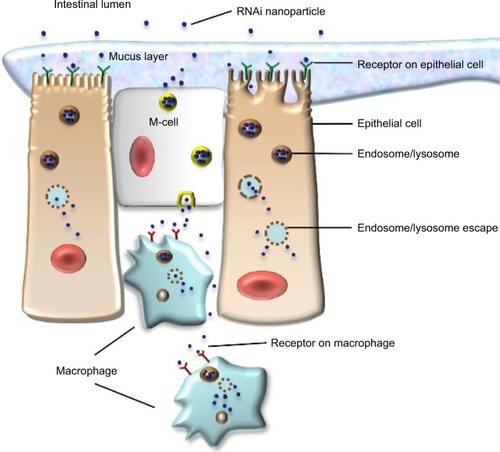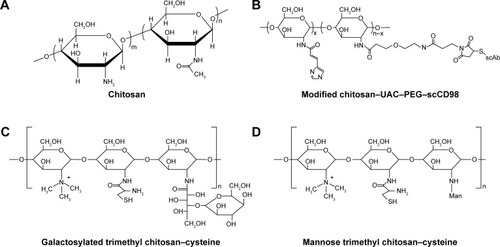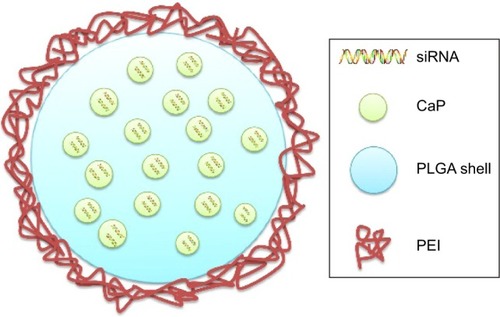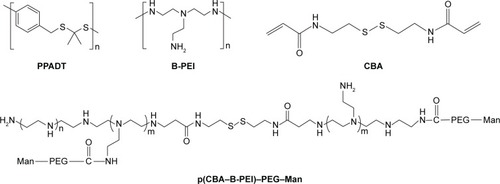Figures & data
Figure 1 RNAi nanoparticles target to epithelial cells or macrophages in intestinal lumen.
Abbreviation: RNAi, RNA interference.

Table 1 Summary of siRNA nanosystems in IBD treatment
Table 2 Silencing experiments of different siRNA nanosystems in vitro and vivo
Figure 2 Chitosan-based nanoparticle delivery systems for siRNA delivery in IBD treatment.
Notes: Chemical structures of chitosan (A) and chitosan-based delivery systems (B–D).
Abbreviations: IBD, inflammatory bowel disease; PEG, polyethylene glycol; ScCD98, single-chain CD98; siRNA, short interfering RNA; UAC, urocanic acid.

Figure 3 Other polysaccharides for siRNA delivery in IBD treatment.
Notes: Chemical structures of modified amphiphilic cyclodextrin (A), β-1,3-d-glucan (B), and konjac glucomannan (C).
Abbreviations: IBD, inflammatory bowel disease; siRNA, short interfering RNA.

Figure 4 PLA-based nanoparticle delivery systems for siRNA delivery in IBD treatment.
Notes: Chemical structures of PLA, PVA, and PLA–PEG–maleimide–Ab.
Abbreviations: Ab, antibody; IBD, inflammatory bowel disease; PEG, polyethylene glycol; PLA, polylactide; PVA, polyvinyl alcohol; siRNA, short interfering RNA.

Figure 5 Schematic illustration of CaP/PLGA-based nanoparticles.
Abbreviations: CaP, calcium phosphate; PEI, polyethylenimine; PLGA, poly(d,l-lactide-co-glycolide acid); siRNA, short interfering RNA.

Figure 6 Schematic illustration of nanoparticles in the microsphere system.
Abbreviations: PCL, poly-ε-caprolactone; siRNA, short interfering RNA.

Figure 7 Thioketal and PEI-based nanoparticulate delivery system for siRNA delivery in IBD treatment.
Notes: Chemical structures of PPADT, B-PEI, CBA, and p(CBA–B-PEI)–PEG–Man.
Abbreviations: B-PEI, branched-polyethylenimine; CBA, cystamine bisacrylamide; IBD, inflammatory bowel disease; Man, mannose; PEG, polyethylene glycol; siRNA, short interfering RNA.

Figure 8 Colon histological sections stained with H&E from mice receiving different kinds of nanoparticles.
Notes: Colon histological sections stained with H&E from mice receiving normal water and gavage of phosphate buffer saline (A). Colon histological sections stained with H&E from DSS-induced mice receiving daily gavage of phosphate buffer saline (B), scramble-siRNA-loaded TKNs (C), TNF-α-siRNA-loaded TKNs (D), TNF-α-siRNA-loaded PLGA nanoparticles (E), or TNF-α-siRNA-loaded β-glucan particles (F). Adapted by permission from Macmillan Publishers Ltd: [Nat Mater],Citation84 copyright (2010). The β-glucan particles (F) have demonstrated siRNA carrying ability by oral administration in inflammatory treatment at previous studies.Citation59
Abbreviations: DSS, dextran sulfate sodium; H&E, hematoxylin/eosin; siRNA, short interfering RNA; TKNs, thioketal nanoparticles; TNF, tumor necrosis factor.
![Figure 8 Colon histological sections stained with H&E from mice receiving different kinds of nanoparticles.Notes: Colon histological sections stained with H&E from mice receiving normal water and gavage of phosphate buffer saline (A). Colon histological sections stained with H&E from DSS-induced mice receiving daily gavage of phosphate buffer saline (B), scramble-siRNA-loaded TKNs (C), TNF-α-siRNA-loaded TKNs (D), TNF-α-siRNA-loaded PLGA nanoparticles (E), or TNF-α-siRNA-loaded β-glucan particles (F). Adapted by permission from Macmillan Publishers Ltd: [Nat Mater],Citation84 copyright (2010). The β-glucan particles (F) have demonstrated siRNA carrying ability by oral administration in inflammatory treatment at previous studies.Citation59Abbreviations: DSS, dextran sulfate sodium; H&E, hematoxylin/eosin; siRNA, short interfering RNA; TKNs, thioketal nanoparticles; TNF, tumor necrosis factor.](/cms/asset/7a64ddbc-fe51-4a08-a037-2bd924f01aa8/dijn_a_12193422_f0008_c.jpg)
Table 3 Challenges of RNAi molecular delivery in IBD
